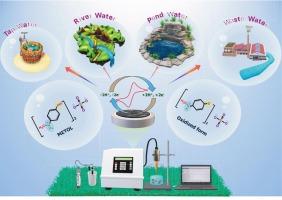Tweaking the electrocatalytic efficiency of sonochemically synthesized Bi2S3 nanorods through decoration with f-MWCNTs: A selective on-site detection of METOL in environmental samples
IF 9.7
1区 化学
Q1 ACOUSTICS
引用次数: 0
Abstract
In this study, we have established a highly conductive Bi2S3/f-MWCNT nanocomposite through a sonochemical approach using a probe sonicator (100 W, 25 kHz), which functions as an effective electrochemical probe for the detection of 4-(methylamino)phenol sulfate or METOL (MET) in environmental water samples. MET, a widely used chemical in hair dyes and the photographic industries, poses significant environmental concerns when released into water systems, contributing to water pollution and ecological disruption. Comprehensive characterization techniques confirmed the structural integrity and enhanced electrochemical properties of the Bi2S3/f-MWCNT nanocomposite. The as-prepared Bi2S3/f-MWCNT demonstrated exceptional sensing capabilities, with a phenomenal limit of detection of 6.52 nM within a linear range of 0.01 to 2100 μM, and exhibited a sensitivity of 10. 514 μA μM−1 cm−2. The practical applicability of the sensor was validated through its successful use in detecting MET in real-world environmental samples, such as river water, pond water, wastewater, and tap water. Additionally, the integration of the Bi2S3/f-MWCNT sensor with a smart potentiostat provides a powerful platform for on-site monitoring of water quality. This work offers a promising approach for the detection of industrial pollutants and provides a potential solution for advancing environmental sustainability.

通过修饰f-MWCNTs调整声化学合成Bi2S3纳米棒的电催化效率:环境样品中METOL的选择性现场检测
在这项研究中,我们利用探针声纳器(100 W, 25 kHz)通过声化学方法建立了一种高导电性的Bi2S3/f-MWCNT纳米复合材料,作为一种有效的电化学探针,用于检测环境水样中的4-(甲基胺)苯酚硫酸盐或METOL (MET)。MET是一种广泛用于染发剂和摄影工业的化学物质,当它被排放到水系统中时,会造成严重的环境问题,造成水污染和生态破坏。综合表征技术证实了Bi2S3/f-MWCNT纳米复合材料的结构完整性和增强的电化学性能。制备的Bi2S3/f-MWCNT表现出优异的传感能力,在0.01 ~ 2100 μM的线性范围内,检测限为6.52 nM,灵敏度为10。514 μA - m - 1 cm - 2。通过在实际环境样品(如河水、池塘水、废水和自来水)中成功检测MET,验证了该传感器的实用性。此外,Bi2S3/f-MWCNT传感器与智能恒电位器的集成为现场水质监测提供了强大的平台。这项工作为工业污染物的检测提供了一种有前途的方法,并为促进环境可持续性提供了一种潜在的解决方案。
本文章由计算机程序翻译,如有差异,请以英文原文为准。
求助全文
约1分钟内获得全文
求助全文
来源期刊

Ultrasonics Sonochemistry
化学-化学综合
CiteScore
15.80
自引率
11.90%
发文量
361
审稿时长
59 days
期刊介绍:
Ultrasonics Sonochemistry stands as a premier international journal dedicated to the publication of high-quality research articles primarily focusing on chemical reactions and reactors induced by ultrasonic waves, known as sonochemistry. Beyond chemical reactions, the journal also welcomes contributions related to cavitation-induced events and processing, including sonoluminescence, and the transformation of materials on chemical, physical, and biological levels.
Since its inception in 1994, Ultrasonics Sonochemistry has consistently maintained a top ranking in the "Acoustics" category, reflecting its esteemed reputation in the field. The journal publishes exceptional papers covering various areas of ultrasonics and sonochemistry. Its contributions are highly regarded by both academia and industry stakeholders, demonstrating its relevance and impact in advancing research and innovation.
 求助内容:
求助内容: 应助结果提醒方式:
应助结果提醒方式:


